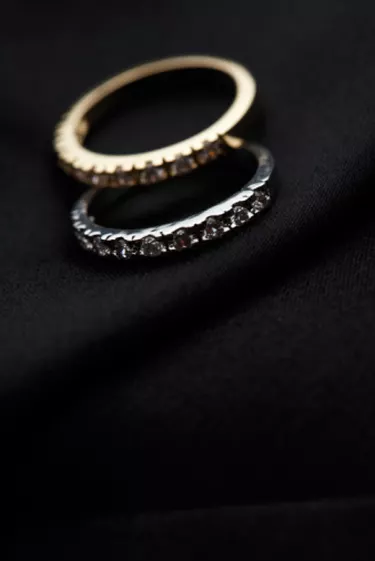
Italy possesses insignificant amounts of gold itself , it is imported mainly from South Africa. To that extent there is nothing unique about Italian gold, it is the same as gold everywhere. What is referred to is the special flair and skill in jewellery design that the Italians have been famous for since Etruscan times. 70% of Italy's production is for export , roughly 450 tons per year, making it the worlds third largest exporter. With these statistics it is right to expect many people to have Italian gold in their possession and to be interested in testing its value and provenance. Testing for Italian gold involves testing for gold, and then testing if the gold was worked in Italy.
Testing for Gold
Video of the Day
Step 1
Make a slight nick into the surface of the gold at a place which will not affect the appearance of the piece.
Video of the Day
Step 2
Place some nitric acid into the mark. Take care not to inhale any fumes, use only a small amount , and wear protective gloves.
Step 3
Notice any fizzing or bubbling :this would indicate a chemical reaction with baser metals underneath if jewellery is only plated and not solid gold.
Step 4
Avoid performing this test at a joint on the piece. Solder may have been used to make the join and so compromise the test results..
Step 5
A more informal version of this test is if the piece being examined causes any green or black marks on the skin when worn. This indicates that the baser metals in the item are reacting with the acid on the skin.
Made in Italy?
Step 1
Check on the inside for markings. By law Italian jewellery should be marked with: gold rating, company name, and country of origin.
Step 2
Most Italian gold for export is 14K (also indicated as '585', which means 58.5% gold, for Europe) and 18K (also indicated as '750' i.e. 75% gold).
Step 3
The company name may not always be given, but there is usually the marking 'Italy' or 'Italia'. You may also find the Italian for gold which is 'oro'.
Step 4
Sometimes the name of the design house is found on the piece, and this can be a source of confirmation if the gold piece is really from Italy. There are over 10,000 firms making jewellery in Italy. 50% of the jewellery manufactured comes from 1,400 firms in Arezzo, but other important centers are Vizenza, Valenza,and Torre del Greco. The company name can be checked on line to see if it is bona fide.
Tip
The jewellery can be white or yellow gold. Both are popular among Italian jewellery manufacturers. The white gold is purer, hence stronger, while yellow gold is mixed with brass or other metals and softer. strength testing is best carried out by an expert as the jewellery could be permanently damaged if the testing is not done correctly.
Things You'll Need
Small metal file
nitric acid and dropper
protective gloves